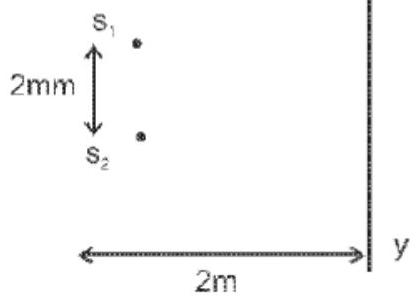Wave Optics - Result Question 16
16. In Young’s doubleslit experiment, the slits are $2 mm$ apart and are illuminated by photons of two wavelengths $\lambda_1=12000 \AA$ and $\lambda_2=10000 \AA$. At what minimum distance from the common central bright fringe on the screen $2 m$ from the slit will a bright fringe from one interference pattern coincide with a bright fringe from the other?
[2013]
(a) $6 mm$
(b) $4 mm$
(c) $3 mm$
(d) $8 mm$
Show Answer
Answer:
Correct Answer: 16. (a)
Solution:
- (a) $\because Y=\frac{n \lambda D}{d}$
$\therefore n_1 \lambda_1=n_2 \lambda_2$
$\Rightarrow n_1 \times 12000 \times 10^{-10}=n_2 \times 10000 \times 10^{-10}$
or, $n(12000 \times 10^{-10})=(n+1)(10000 \times 10^{-}.$
$.{ }^{10}) \Rightarrow n=5$
$(\because \lambda_1=12000 \times 10^{-10} m ; \lambda_2=10000 \times 10^{-10} m)$

Hence, $Y _{\text{common }}=\frac{n \lambda_1 D}{d}$
$=\frac{5(12000 \times 10^{-10}) \times 2}{2 \times 10^{-3} /(\because d=2 mm \text{ and } D=2 m)}$
$=5 \times 12 \times 10^{-4} m$
$=60 \times 10^{-4} m$
$=6 \times 10^{-3} m=6 mm$






